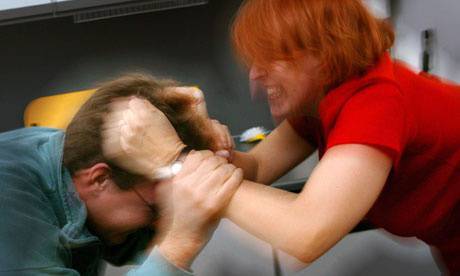Campaign group Parity claims assaults by wives and girlfriends are often ignored by police and media.
About two in five of all victims of domestic violence are men, contradicting the widespread impression that it is almost always women who are left battered and bruised, a new report claims.
Men assaulted by their partners are often ignored by police, see their attacker go free and have far fewer refuges to flee to than women, says a study by the men's rights campaign group Parity.
The charity's analysis of statistics on domestic violence shows the number of men attacked by wives or girlfriends is much higher than thought. Its report, Domestic Violence: The Male Perspective, states: "Domestic violence is often seen as a female victim/male perpetrator problem, but the evidence demonstrates that this is a false picture."
Data from Home Office statistical bulletins and the British Crime Survey show that men made up about 40% of domestic violence victims each year between 2004-05 and 2008-09, the last year for which figures are available. In 2006-07 men made up 43.4% of all those who had suffered partner abuse in the previous year, which rose to 45.5% in 2007-08 but fell to 37.7% in 2008-09.
Similar or slightly larger numbers of men were subjected to severe force in an incident with their partner, according to the same do

ents. The figure stood at 48.6% in 2006-07, 48.3% the next year and 37.5% in 2008-09, Home Office statistics show.
The 2008-09 bulletin states: "More than one in four women (28%) and around one in six men (16%) had experienced domestic abuse since the age of 16. These figures are equivalent to an estimated 4.5 million female victims of domestic abuse and 2.6 million male victims."
In addition, "6% of women and 4% of men reported having experienced domestic abuse in the past year, equivalent to an estimated one million female victims of domestic abuse and 600,000 male victims".
Campaigners claim that men are often treated as "second-class victims" and that many police forces and councils do not take them seriously. "Male victims are almost invisible to the authorities such as the police, who rarely can be prevailed upon to take the man's side," said John Mays of Parity. "Their plight is largely overlooked by the media, in official reports and in government policy, for example in the provision of refuge places – 7,500 for females in England and Wales but only 60 for men."
The official figures underestimate the true number of male victims, Mays said. "Culturally it's difficult for men to bring these incidents to the attention of the authorities. Men are reluctant to say that they've been abused by women, because it's seen as unmanly and weak."
The number of women prosecuted for domestic violence rose from 1,575 in 2004-05 to 4,266 in 2008-09. "Both men and women can be victims and we know that men feel under immense pressure to keep up the pretence that everything is OK," said Alex Neil, the housing and communities minister in the Scottish parliament. "Domestic abuse against a man is just as abhorrent as when a woman is the victim."
Mark Brooks of the Mankind Initiative, a helpline for victims, said: "It's a scandal that in 2010 all domestic violence victims are still not being treated equally. We reject the gendered analysis that so many in the domestic violence establishment still pursue, that the primary focus should be female victims. Each victim should be seen as an individual and helped accordingly."

 to blows we'd get over it and afterwards have great make-up sex
to blows we'd get over it and afterwards have great make-up sex 